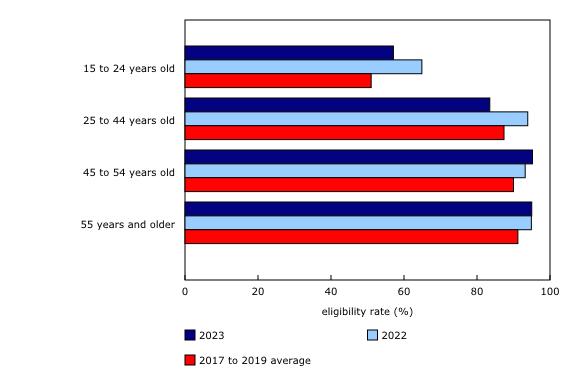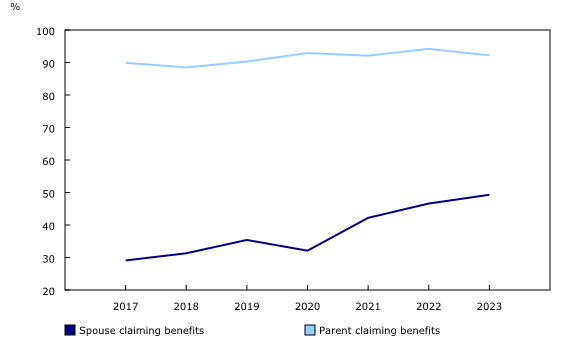Employment Insurance Coverage Survey, 2023
Released: 2024-10-30
New data from the 2023 Employment Insurance Coverage Survey (EICS) provide an overview of who has access to regular Employment Insurance (EI) benefits, and why people may not have access to benefits. The survey also covers Canadian parents' use of the maternity and parental benefits available under the EI program. All these benefits provide temporary income support while people are not working.
In 2023, an average of 1.1 million Canadians were unemployed at any point during the year. Two-thirds of these people (66.0% or 744,000) had contributed to the EI program. This contribution rate was up from 59.2% in 2022 and above the average from 2017 to 2019 (62.8%).
To be eligible for regular EI benefits, one must have contributed to the EI program, have a valid job separation (for example, were laid off or quit for just cause), and have accumulated enough insurable hours (see the infographic "Employment Insurance coverage and eligibility in 2023").
The EI eligibility rate is the number of people who had accumulated enough insurable hours to be eligible to receive regular EI benefits, expressed as a proportion of all those who were unemployed in 2023, had contributed to EI and had a valid job separation (for example, laid off or quit for just cause).
The eligibility rate in 2023 was 83.1%, down 6.5 percentage points from 2022. This was just below the average eligibility rate of 84.7% during the period from 2017 to 2019, prior to the COVID-19 pandemic. For part of 2022, eligibility requirements were still temporarily changed in response to the pandemic, which may have contributed to a higher eligibility rate. In 2023, eligibility requirements for regular EI had returned to standard requirements.
Employment Insurance eligibility rate highest in Prince Edward Island and Newfoundland and Labrador
In 2023, eligibility rates for regular EI benefits were highest in the Atlantic provinces, led by Prince Edward Island (96.1%) and Newfoundland and Labrador (95.6%). This is consistent with historical trends in the Atlantic provinces, where both the contribution rate and eligibility rate have remained relatively high.
Eligibility rates were lowest in Alberta (74.7%), Ontario (80.1%) and Saskatchewan (80.5%) in 2023. In all 10 provinces, eligibility rates were down compared with 2022.
Eligibility rates fall most among people aged 25 to 44
The EI eligibility rate among people aged 25 to 44 was 83.5% in 2023, down 10.4 percentage points from 93.9% in 2022. The eligibility rates for people aged 45 to 54 (95.2%) and those 55 years and older (95.0%) were each little changed compared with 2022.
For youth aged 15 to 24, the eligibility rate was 57.1% in 2023, down 7.8 percentage points from a year earlier. Lower eligibility rates indicate that fewer people had accumulated the insurable hours prior to unemployment needed to be eligible to receive regular EI benefits.
Youth EI eligibility rates have historically been lower than the rate for older age groups, as youth are less likely to accumulate enough insurable work hours. They are also more likely to have an invalid job separation; reasons not deemed valid by the EI program include voluntarily leaving a job without just cause, including leaving a job to go back to school.
Contribution rate increases for women while eligibility rate falls
In 2023, the EI eligibility rate remained lower for women (76.4%) than for men (88.6%). Moreover, from 2022 to 2023, the eligibility rate fell more for women (-7.5 percentage points) than for men (-4.7 percentage points). At the same time, proportionally more women had contributed to the EI program before becoming unemployed in 2023 (64.2%) than in 2022 (52.2%).
Women were more likely to have last worked in part-time employment (31.7%) before unemployment, compared to men (17.0%). Part-time workers are less likely to have accumulated enough insurable hours prior to unemployment, a factor which may have contributed to a lower eligibility rate among women in 2023.
Maternity and parental benefits
In addition to regular benefits, there are other types of EI benefits, including maternity and parental benefits. The EICS surveys one parent per household, usually recent mothers, and then asks about the benefits their spouse or partner may also have taken.
In 2023, more than three-quarters (78.3%) of parents with a child aged 18 months or younger had paid EI premiums before the birth or adoption of their child. Among these parents, the vast majority of whom were mothers, 92.2% received maternity or parental benefits, compared to 94.2% in 2022 and 92.1% in 2021.
Among the spouses or partners of surveyed parents (the vast majority of whom were fathers), 49.3% had claimed or intended to claim paternity or parental benefits in 2023, up from 46.6% in 2022 and 42.2% in 2021.
In Quebec, maternity and parental benefits are offered through the Québec Parental Insurance Plan (QPIP), and historically a higher proportion of spouses or partners receive benefits in Quebec compared with other provinces. However, the gap has narrowed in recent years. In 2023, 80.2% of spouses or partners in Quebec had claimed or intended to claim paternity or parental benefits from QPIP, down from 92.9% in 2022. In provinces outside Quebec, 39.3% of spouses or partners claimed or intended to claim benefits in 2023, up 8.0 percentage points from a year earlier.
Did you know we have a mobile app?
Download our mobile app and get timely access to data at your fingertips! The StatsCAN app is available for free on the App Store and on Google Play.
Note to readers
The Employment Insurance Coverage Survey sheds light on the coverage of the Employment Insurance (EI) program. It provides an overview of who does or does not have access to EI regular benefits as well as to maternity and parental benefits.
To be eligible to receive EI regular benefits, unemployed individuals have to: (a) contribute to the EI program, (b) meet the criteria for job separation (that is, have a valid job separation) and (c) have accumulated enough insurable hours over the past 12 months.
Job separations that are deemed invalid to receive regular benefits include, among others, quitting the job without just cause (including leaving a job to go to school, dissatisfaction with the job and retirement) or dismissal with cause.
The number of unemployed people who had accumulated enough insurable hours to be eligible to receive regular EI benefits, expressed as a proportion of unemployed people who were covered by the EI program and separated from their job for a reason deemed valid by the program, is known as the "eligibility rate."
The number of insured hours required to qualify for regular benefits varies across geographic regions, ranging from 420 to 700 hours, depending on the region's unemployment rate. The higher the unemployment rate, the lower the number of hours required to qualify for benefits. For maternity and parental benefits (excluding Quebec), the required number of insured hours to qualify for benefits is 600. Eligibility for benefits under the Québec Parental Insurance Plan is not based on a minimum number of insured hours.
There are two main reasons for not contributing to the EI program: not having worked in the previous 12 months (which includes those who have never worked), and non-insurable employment (which includes self-employment).
The survey is administered to a sub-sample of respondents of the Labour Force Survey (LFS) four times a year, namely in April, July, November and January. Respondents are asked questions about their situation during the LFS reference week in the month prior to being interviewed (March, June, October and December, respectively). The estimates are produced for the reference year by averaging over the four cycles covered by the survey.
In 2023, the total sample size was 12,590 people, composed of unemployed individuals (as defined by the LFS) and other individuals who, given their recent status in the labour market, were potentially eligible for EI.
The survey is conducted on behalf of Employment and Social Development Canada.
Contact information
For more information, or to enquire about the concepts, methods or data quality of this release, contact us (toll-free 1-800-263-1136; 514-283-8300; infostats@statcan.gc.ca) or Media Relations (statcan.mediahotline-ligneinfomedias.statcan@statcan.gc.ca).
- Date modified:




